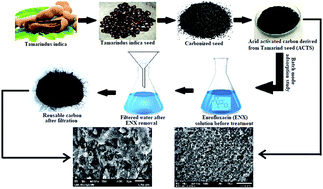The biosorptive uptake of enrofloxacin from synthetically produced contaminated water by tamarind seed derived activated carbon
Abstract
The veterinary antibiotic enrofloxacin (ENR), an emerging contaminant, poses great concern due to its ubiquitous nature. Efforts have been made to eliminate ENR from synthetic aqueous solutions through applying an adsorption process, using tamarind-seed-derived carbon chemically activated with 85% (w/w) ortho-phosphoric acid (ACTS) as an adsorbent. ACTS was characterized via BET studies, SEM, EDX spectroscopy, FT-IR spectroscopy, etc. Parametric optimization was performed with the aid of a Taguchi L16 orthogonal array approach, aimed at maximizing the ENR percentage removal (% R). Analysis of variance (ANOVA) results revealed that temperature, chosen as one of the process parameters, had insignificant effects. % R was found to be maximum (95.11%) at a contact time of 15 h, a pH of 8, an ACTS dose of 8 g L−1 and an initial ENR concentration of 10 mg L−1. Equilibrium and kinetics studies revealed that the adsorption process followed a Redlich–Peterson isotherm model and a pseudo-second-order kinetics model. Reusability studies were performed, which showed that the developed adsorbent is reusable and regenerable. ACTS is also cost-effective, as the laboratory preparation of ACTS incurred a cost of INR 246. Finally, the ENR-laden ACTS was safely disposed of following WHO guidelines.



 Please wait while we load your content...
Please wait while we load your content...